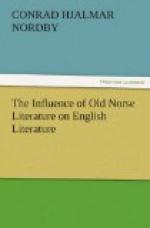The white and silent woman above the slaughter set.
As we turn from the scene and the book, that figure fades not away. And it is fitting that the last memory of this poem should be a picture of love and hate, inextricably bound together, for that is the irony of Fate, and Fate was mistress of the Old Norseman’s world.
5.
Between the great works dealt with in the last two sections, which belong together and were therefore so considered, came the book of 1875, bearing the title Three Northern Love Stories and Other Tales. It is as good a representation as Iceland can make in the love-story class.
These tales are charmingly told in the translation of Morris and Magnusson, the second one, “Frithiof the Bold,” being a master-piece in its kind. Men will dare much for the love of a woman, and that is why the sagaman records love episodes at all. Frithiof’s voyage to the Orkneys in Chap. VI is a stormpiece that vies with anything of its kind in modern literature. It is Norse to the core, and we love the peerless young hero who forgets not his manhood in his chagrin of defeat at love. Surely there is fitness in these outbursts of song in moments of extreme exultation or despair! “And he sang withal:
“Helgi it is that helpeth
The white-head billows’
waxing;
Cold time unlike the kissing
In the close of Baldur’s
Meadow!
So is the hate of Helgi
To that heart’s love
she giveth.
O would that here I held her,
Gift high above all giving!”
Modern literature has lost this conventionality of the older writings, found in Hebrew as well as in Icelandic, and we think it has lost something valuable. Morris thought so, too, for he restored the interpolated song-snatches in his Romances. We are tempted to dwell on these three love-stories, they are so fine; but we must leave them with the remark that they show the poet’s appreciation of the worth of a foreign literature, and his great desire to have his countrymen share in his admiration for them. “The Story of Gunnlaug the Worm-Tongue and Raven the Skald,” and “The Story of Viglund the Fair,” are the other two stories that give the title to the volume, representing the thirteenth and fifteenth centuries, as “Frithiof” represented the fourteenth.
6.
With Sigurd the Volsung ended the first great Icelandic period of Morris’s work. More than a dozen years passed before he returned to the field, and from 1889 until his death, in 1896, everything he wrote bore proofs of his abiding interest in and affection for the ancient literature. The remarkable series of romances, The House of the Wolfings (1889), The Roots of the Mountains (1890), The Story of the Glittering Plain (1891), The Wood Beyond the World (1895), The Well at the World’s End (1896) and The Sundering Flood (posthumous), are none of them distinctively Old Norse in geography




